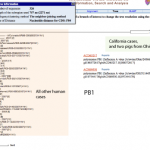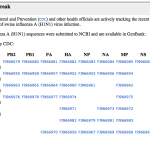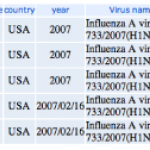Science Education
I am pretty much on record that I would not pay for anything online (to be precise, to pay for content - I certainly use the Web for shopping). But with some caveats. I have been known to hit a PayPal button of people who provide content and information I find valuable. And I would presumably pay, though not being happy about it, if the information behind the pay wall is a) unique (i.e., not found anywhere else by any other means) and b) indispensable for my work (i.e., I would feel handicapped without it).
But I am not subscribed to, or paying for, anything right now and haven't been in…
... In public schools. According to one Federal Judge in the US, not much.
A Mission Viejo high school history teacher violated the First Amendment by disparaging Christians during a classroom lecture, a federal judge ruled today.
James Corbett, a 20-year teacher at Capistrano Valley High School, referred to Creationism as "religious, superstitious nonsense" during a 2007 classroom lecture, denigrating his former Advanced Placement European history student, Chad Farnan.
The decision is the culmination of a 16-month legal battle between Corbett and Farnan - a conflict the judge said…
Nick's post on Amantadine resistance in swine flu was so interesting, I had to look at the protein structures myself.
I couldn't find any structures with the S31N mutation that Nick discussed, but I did find some structures with the M2 protein and Amantadine. Not only are these structures beautiful, but you can look at them and see how the protein works and how the drug prevents the protein from functioning.
As Nick mentions, the M2 protein from influenza makes a channel for hydrogen ions within the viral membrane. The channel controls the pH inside the virus by opening and closing.…
Yet another defeat for the anti-evolutionists. NCSE is reporting that Florida's Senate Bill 2396 has died in committee. To recap:
Mississippi - dead in committee
Oklahoma - dead in committee
Iowa - dead in committee
New Mexico - dead in committee
Florida - dead in committee
Alabama - in committee
Missouri - in committee
Texas - in committee
I can't imagine the Discovery Institute is too happy. It has failed miserably in developing "a new science for a new century" and, having given science up, has failed at legislative action. Time for Plan 9, I think.
No more delays! BLAST away!
Time to blast. Let's see what it means for sequences to be similar.
First, we'll plan our experiment. When I think about digital biology experiments, I organize the steps in the following way:
A. Defining the question
B. Making the data sets
C. Analyzing the data sets
D. Interpreting the results
I'm going intersperse my results with a few instructions so you can repeat the things that I've done…
We'll have a blast, I promise! But there's one little thing we need to discuss first...
I want to explain why I'm going to use nucleotide sequences for the blast search. (I used protein the other day). It's not just because someone told me too, there is a solid rational reason for this.
The reason is the redundancy in the genetic code.
Okay, that probably didn't make any sense to those of you who didn't already know the answer. Here it is.
The picture above shows the human genetic code (there are at least 16 variations on this, but that's another story). Each middle cell in the…
We had a great discussion in the comments yesterday after I published my NJ trees from some of the flu sequences.
If I list all the wonderful pieces of advice that readers shared, I wouldn't have any time to do the searches, but there are a few that I want to mention before getting down to work and posting my BLAST results.
Here were some of the great suggestions and pieces of advice;
1. Do a BLAST search. Right! I can't believe I didn't do that first thing, I think the trees I got surprised me so much all sense flew out of my brain.
2. Show us the multiple alignments. Okay. I'll…
Head First Physics: A learner's companion to mechanics and practical physics I have been watching these Heads Up guides for some time now, mainly in the context of computer software and development. I have not tried any of these guides in IT because, so far, I've felt that while they may be excellent learning resources, they were not ideal reference books, and that is usually what I am looking for. I may be a bit unusual in this regard, but I'm pretty happy reading a reference book from beginning to end, then using later ... as a reference book. In fact, I'd say my ideal combination of…
Last night, the phone rang at 9:22 pm. I quickly glanced at the caller ID. Hmmm. Why is the Seattle School district calling us at this time of night?
Apparently the swine flu has come to Seattle and the school district thought we should know.
Those messages are helpful if you're a parent, but they don't tell much about the rest of the world.
Health Map is a really wonderful, user-friendly, resource for following the epidemic.
When you get to Health Map , choose Select None to clear the map.
Then select Swine Flu.
You'll see a Google map with markers representing reports. The colors show…
I'm teaching an on-line bioinformatics course this semester for Austin Community College. They are in Texas of course, but I am in Seattle. This presents a few interesting challenges and some minor moments of amusement.
Today, the school sent all the faculty emails telling us to stay home if we're sick.
Got it. If I think I have flu, I will not fly to Texas.
Instead, I'll stay home and watch videos on coughing without contaminating others.
Watch "Why don't we do it in our sleeves?" and find out how you rank on the safe coughing scale.
Mark Buchanan, quoting Lee Smolin, on how big science may be biased against innovative iconoclasts:
Some scientists, he suggests, are what we might call "hill climbers". They tend to be highly skilled in technical terms and their work mostly takes established lines of insight that pushes them further; they climb upward into the hills in some abstract space of scientific fitness, always taking small steps to improve the agreement of theory and observation. These scientists do "normal" science. In contrast, other scientists are more radical and adventurous in spirit, and they can be seen as "…
What tells us that this new form of H1N1 is swine flu and not regular old human flu or avian flu?
If we had a lab, we might use antibodies, but when you're a digital biologist, you use a computer.
Activity 4. Picking influenza sequences and comparing them with phylogenetic trees
We can get the genome sequences, piece by piece, as I described in earlier, but the NCBI has other tools that are useful, too.
The Influenza Virus Resource will let us pick sequences, align them, and make trees so we can quickly compare the sequences to each other.
This is how I got the sequences that I wrote about…
This afternoon, I was working on educational activities and suddenly realized that the H1N1 strain that caused the California outbreak might be the same strain that caused an outbreak in 2007 at an Ohio country fair.
UPDATE: I'm not so certain anymore that the strains are the same. I'm doing some work with nucleic acid sequences to look further at similarity.
Here's the data.
Once I realized that the genome sequences from the H1N1 swine flu were in the NCBI's virus genome resources database, I had to take a look.
And, like eating potato chips, making phylogenetic trees is a little bit…
I was pretty impressed to find the swine flu genome sequences, from the cases in California and Texas, already for viewing at the NCBI.
You can get them and work them, too. It's pretty easy. Tomorrow, we'll align sequences and make trees.
Activity 3: Getting the swine flu sequence data
1. Go to the NCBI, find the Influenza Virus Resource page and follow the link to:
04/27/2009: Newest swine influenza A (H1N1) sequences.
2. You'll see a page that looks like this:
Each column heading is a name of a segment of the influenza genome. You can see there are eight of these. Each segment…
I'm a big of learning from data. There are many things we can learn about swine flu and other kinds of flu by using public databases.
In digital biology activity 1, we learned about the kinds of creatures that can get flu. Personally, I'm a little skeptical about the blowfly, but...
Now, you might wonder, what kinds of flu do these different creatures get? Are they all getting H1N1, or do they get different variations? What are H and N anyway?
We can discuss all of these, but for now, lets see what kinds of flu strains infect different kinds of creatures.
Activity 2. What flu infects…
Genome sequences from California and Texas isolates of the H1N1 swine flu are already available for exploration at the NCBI. Let's do a bit of digital biology and see what we can learn.
Activity 1. What kinds of animals get the flu?
For the past few years we've been worrying about avian (bird). Now, we're hearing about swine (pig) flu.
All of this news might you wonder just who gets the flu besides pigs, birds, and humans. We can find out by looking at the data.
Over the past few years, researchers have been sequencing influenza genomes and depositing those genomes in public…
I just learned of this great post from Southern Fried Science via a tweet from Southern Fried Scientist that was retweeted from Rick MacPherson (Malaria, Bedbugs, Sea Lice, and Sunsets). I mention this because my RSS reader is so full of unread posts that Twitter is serving me far better these days by quickly pointing me in the direction of blog posts and articles that would most likely interest me.
The blog is written by Andrew and David - both Southern, both fried, and both smelling of a combination of smoked pork and spiced Low Country shrimp. The blog is characterized as, "The new look…
In the past I have argued that historians of science probably need to get more involved with the fight for good science education. Michael Barton has brought my attention to historian Abigail Lustig giving testimony before the Texas Board of Education.
A couple of years ago, I answered a reader's question about the cost of genome sequencing. One of my readers had asked why the cost of sequencing a human genome was so high. At that time, I used some of the prices advertised by core labs on the web and the reported coverage to estimate the cost of sequencing Craig Venter's genome. As you can imagine, the cost of sequencing has dropped quite a bit since then.
In 2007, Genome Technology reported the cost of sequencing Venter's genome was $70 million. Watson's genome at only $2 million, was a bargain.
Why was Watson's genome so cheap?
Even…
Next time I get down on you slack-jawed yokels in Texas, which could be any time, I don't want to hear any flack. No excuses. You can take my critique in the gut and live with it OR you can tell me to stuff it. But the latter is only an option if you get off your bovine Texas asses and do what you need to do.
State Board of Education Chairman Don McLeroy, R-Bryan, faced searing questioning during his uncommonly long confirmation hearing Wednesday at the Senate Nominations Committee.
And Chairman Mike Jackson, R-La Porte, said McLeroy's nomination is on shaky ground because he might not be…








